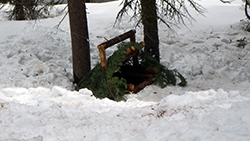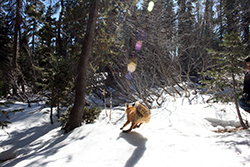
Camouflaged trap used to capture foxes for the study. CDFW photo by Jennifer Carlson.

Sierra Nevada red fox bounds back to its native habitat after capture and study. CDFW photo by Scientific Aide Corrie McFarland.
The Sierra Nevada red fox has been the subject of intensified study by CDFW over the past decade. As they are notoriously tough to track and even tougher to trap, there are many unanswered questions regarding this elusive animal.
In an effort to better understand this state-listed threatened species, an ongoing research project seeks to capture and affix GPS tracking collars to them. The data collected will help biologists better understand the size and characteristics of the fox’s home range, its denning and resting areas, and its foraging habits.
The species has been outfoxing researchers for some time -- to the point where in the 1980s, it was presumed to have vanished forever from its historically occupied habitat in the Cascade and Sierra Nevada ranges. In March 1993, thanks to the then-emerging technology of infrared trail cameras, US Forest Service employees detected a single red fox in the Lassen National Forest.
That discovery prompted a wider study of foxes and other meso-carnivores in and around Lassen Volcanic National Park. In the late 1990s and early 2000s, Dr. John Perrine of the University of California, Berkeley, captured five individuals, primarily in the park, and placed radio collars on them to study their home range (both summer and winter), food habits and resting sites. Unfortunately, two of the collared individuals died within a year and none of the females reproduced during the course of the study.
Years later, CDFW launched a new study to determine the foxes’ current distribution in northern California and to address potential impacts on the species from activities including recreation and timber harvest. Initial efforts in 2008 used scat-detector dogs to survey portions of Lassen Volcanic National Park and the adjacent Caribou Wilderness. Then, from 2009 to 2011, trail cameras and hair-snaring devices were employed to survey high-elevation habitats in the Cascade Range from Mount Shasta to Lassen Peak. Yet foxes were only detected in the Lassen Peak area.
CDFW biologists have continued to survey for foxes with trail cameras, hair-snaring devices and scat surveys. Scats and photos are often obtained along Lassen Volcanic National Park and Forest Service hiking trails, because, like many other animals, red foxes frequent trails as they move through their territories. Analysis of the DNA contained in the collected scats and hair identified 22 individuals from 2007-2016. Some of these foxes are long-lived – samples collected over time from the same individual indicate that five of those individuals lived at least five and a half years.
CDFW efforts to capture and collar Sierra Nevada red foxes since 2013 were unsuccessful – until early February 2018. The nearly two decade-long dry spell came to an end at last when CDFW captured a Sierra Nevada red fox, a male that weighed about 10 pounds. It was captured in a “log cabin” style trap on National Forest land just outside of Lassen Volcanic National Park, near the town of Mineral. The fox was collared and released at the capture location, and CDFW biologists have been impressed by the distances he has regularly been covering since (five to six miles per day) despite the rough terrain and high elevation.
“Persistence played a large role in our success, because there are many days when we do not have any fox detections,” said CDFW Wildlife Biologist Jennifer Carlson. “We also ramped up our efforts this year by hiring two scientific aids rather than just one, which allowed us to literally double our efforts by putting more traps out across the study area.”
CDFW hopes to capture as many as four more red foxes this year. Scientists are using box traps, cage traps and a “log cabin” style trap that researchers have used in other states to capture both red foxes and wolverines. Capturing foxes is not an easy task given the cold temperatures and snowstorms, but as the Lassen population may only consist of around 20 individuals, it is imperative for the department to learn as much as it can about this stealthy animal.
For more information, please visit the Sierra Nevada red fox page.
Top photo: Senior Environmental Scientist Pete Figura and Senior Wildlife Veterinarian Deana Clifford release a red fox study subject. CDFW photo by Corrie McFarland